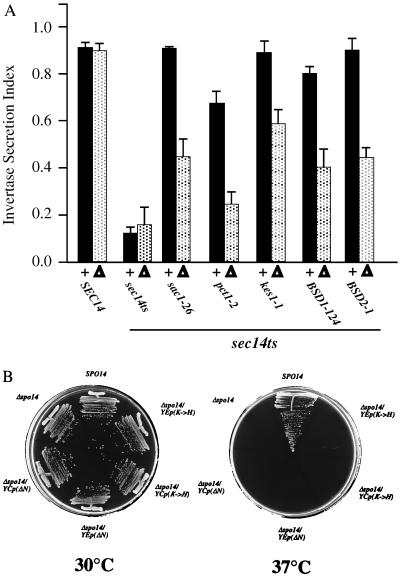Figure 3.
(A) Efficiency of invertase secretion in wild-type, sec14–1ts, and ‘bypass Sec14p’ strains as a function of PLD. The secretion index measures invertase secretion efficiency at 37°C (24). Wild-type and sec14–1ts parental strains indicate secretory efficiency under Sec14p-proficient and deficient conditions, respectively, while the secretion indices of the various ‘bypass Sec14p’ strains quantitate the efficiency with which the indicated mutations suppress sec14–1ts-associated secretory defects. The SPO14 strain data are presented as solid bars and indicated (+) below them (n ≥ 4). The spo14Δ strain data are presented as stippled bars and indicated (Δ) below them (n ≥ 4). Strains are described in Fig. 2B. (B) PLD catalytic activity is not sufficient for ‘bypass Sec14p’. A set of isogenic sec14–1ts, pct1–2 strains were streaked for single colonies on YPD medium and incubated for 48 hr at the indicated temperatures. The SPO14 derivative (CTY102) served as a positive ‘bypass Sec14p’ control (robust growth at 37°C) while the spo14Δ derivative (CTY1096) represented the ‘bypass Sec14p’-incompetent control (no growth at 37°C). Complementation of spo14Δ in the ‘bypass Sec14p’ context was assessed for low-copy (YCp) and high-copy (YEp) configurations of the spo14ΔN allele (indicated as ΔN; encodes a catalytically active PLD that fails to undergo localization to the nuclear membrane during meiosis; ref. 26) and the spo14K→H allele (encodes catalytically inactive PLD; refs. 20 and 28).

